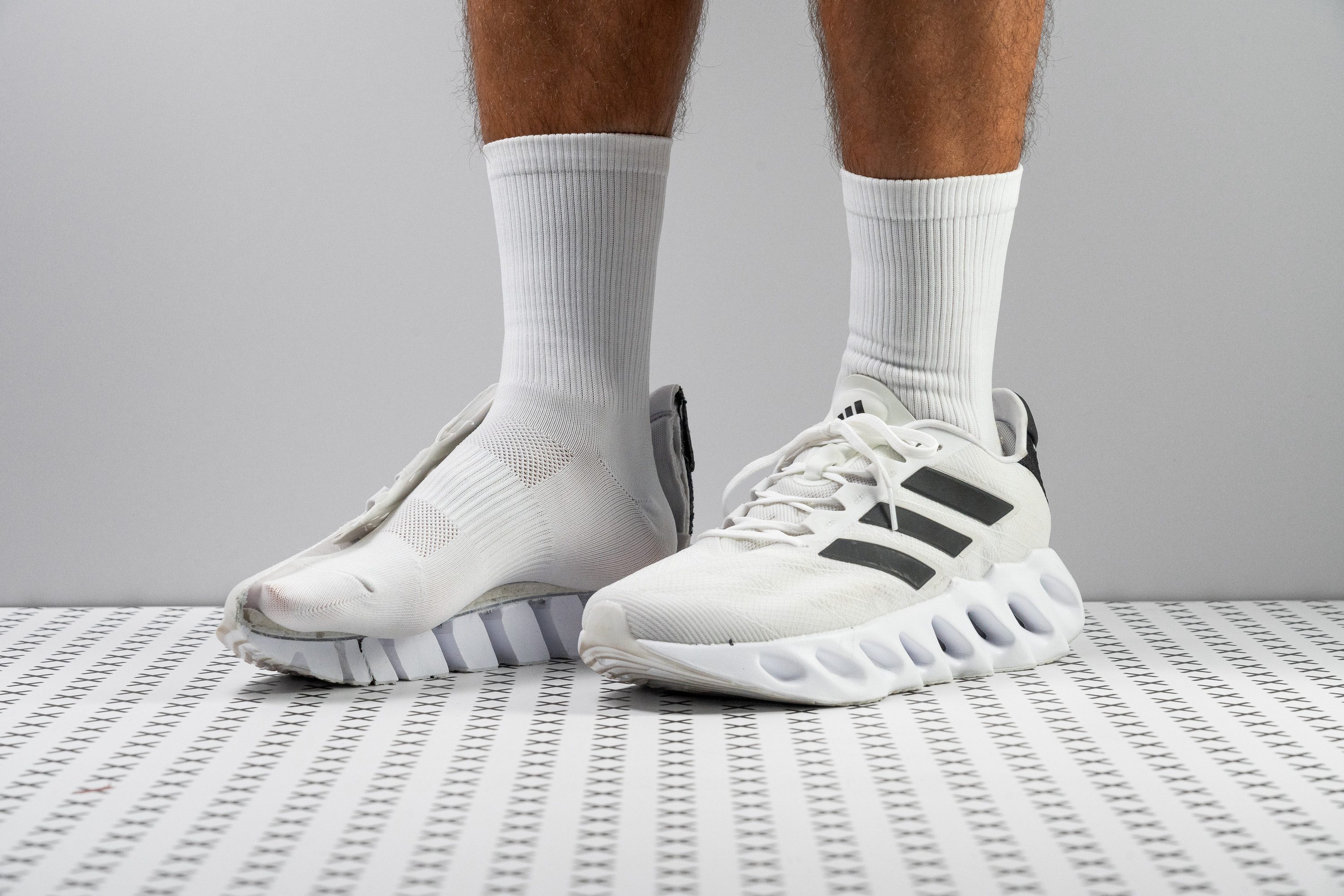Nuestra conclusión
Pros
- Muy estables
- Parte superior más duradera
- Pesan menos que la v1
- Estética única
- Precio competitivo
- Flexibles y cómodas para caminar
- Sujetan bien el talón
- Más baratas que la mayoría de los modelos de On
- Elementos reflectantes muy grandes
Contras
- No son muy reactivas
- Suela exterior que atrapa piedrecitas y se desgasta rápido
- Podrían ser más transpirables
- A la parte superior le falta espacio vertical
Veredicto de los usuarios
Comparativa
Las zapatillas de running más parecidas
+ + Añadir unas zapatillas | |||||
|---|---|---|---|---|---|
| Puntuación global | 85 Buenas | 89 Notables | 90 Excelentes | 80 Buenas | |
| Precio | 140 € | 140 € | 190 € | 100 € | |
| Pace | Correr a diario | Correr a diario | Correr a diario | Correr a diario | |
| Absorción de impactos | - | Alta | Alta | - | |
| Retorno de energía | - | Bajo | Moderado | - | |
| Tracción | - | Moderada | Alta | - | |
| Arch support | Neutral | Neutral | Neutral | Neutral | |
| Peso laboratorio Peso marca | 10.2 oz / 288g 10.4 oz / 294g | 9.7 oz / 274g 9.5 oz / 270g | 9.6 oz / 272g 9.7 oz / 275g | 12 oz / 340g 12.5 oz / 354g | |
| Drop laboratorio Drop marca | 11.7 mm 10.0 mm | 10.5 mm 5.0 mm | 9.4 mm 6.0 mm | 11.5 mm 10.0 mm | |
| Técnica de carrera | Talón | Talón | TalónMedio/antepié | Talón | |
| Talla | Tallan bien | Tallan bien | Tallan bien | Tallan bien | |
| Rigidez de la mediasuela | Equilibrada | Blanda | Equilibrada | Equilibrada | |
| Diferencia de la rigidez de la mediasuela en frío | Normal | Normal | Pequeña | Pequeña | |
| Durabilidad de la parte delantera | Decente | Mala | Decente | Mala | |
| Durabilidad del acolchado del talón | Alta | Media | Baja | Baja | |
| Durabilidad de la suela exterior | Decente | Buena | Buena | Buena | |
| Transpirabilidad | Media | Alta | Media | Media | |
| Anchura / ajuste | Media | Media | Media | Media | |
| Anchura de la parte delantera | Media | Media | Media | Estrecha | |
| Flexibilidad | Rígida | Moderada | Rígida | Rígida | |
| Rigidez torsional | Rígidas | Rígidas | Rígidas | Rígidas | |
| Rigidez del contrafuerte del talón | Moderado | Rígido | Moderado | Moderado | |
| Rocker | ✗ | ✗ | ✓ | ✗ | |
| Talón laboratorio Talón marca | 44.0 mm 46.0 mm | 40.7 mm 40.0 mm | 39.9 mm 37.0 mm | 37.7 mm 20.0 mm | |
| Antepié laboratorio Antepié marca | 32.3 mm 36.0 mm | 30.2 mm 35.0 mm | 30.5 mm 31.0 mm | 26.2 mm 10.0 mm | |
| Anchuras disponibles | Estándar | EstándarAncho | Estándar | Estándar | |
| Orthotic friendly | ✓ | ✓ | ✓ | ✓ | |
| Estación | Todas las estaciones | VeranoTodas las estaciones | Todas las estaciones | Todas las estaciones | |
| Removable insole | ✓ | ✓ | ✓ | ✓ | |
| Clasificación | #219 41% inferior | #103 Top 28% | #40 Top 11% | #307 18% inferior | |
| Popularidad | #266 29% inferior | #242 35% inferior | #203 45% inferior | #182 Top 49% |
Quién debería comprárselas
Les recomendamos las Adidas Switch FWD 2 a:
- Los principiantes que están buscando unas zapatillas con mucha amortiguación que sean ideales para salir a pasear de vez en cuando e incluso correr un poquito ocasionalmente.
- Los corredores que están buscando unas zapatillas maximalistas con un drop alto que sean estables y que no cuesten un ojo de la cara.
- Los fans de las Switch FWD originales a los que les gusta su diseño único pero que quieren una versión más ligera. ¡Y aquí la tienen!

Quién NO debería comprárselas
Aunque parece que van a tener más rebote que un muelle, las Switch FWD 2 se quedan cortas en cuanto a impulso, así que no nos parecen la mejor opción para los corredores experimentados que están buscando un buen retorno de energía. Hemos descubierto que las On Cloudmonster 2, que tienen una suela más alta, o las On Cloudsurfer 7, que ofrecen una experiencia más equilibrada, llenan de energía la pisada y tienen una mediasuela con un diseño parecido.
Además, el drop alto de las Switch FWD 2 puede no gustarles a los corredores que están buscando un modelo un poco más plano. A los que prefieren un drop más bajo y una sensación más blanda bajo los pies les recomendamos echarle un ojo a las ASICS Novablast 4 o a las New Balance Fresh Foam X More v5.
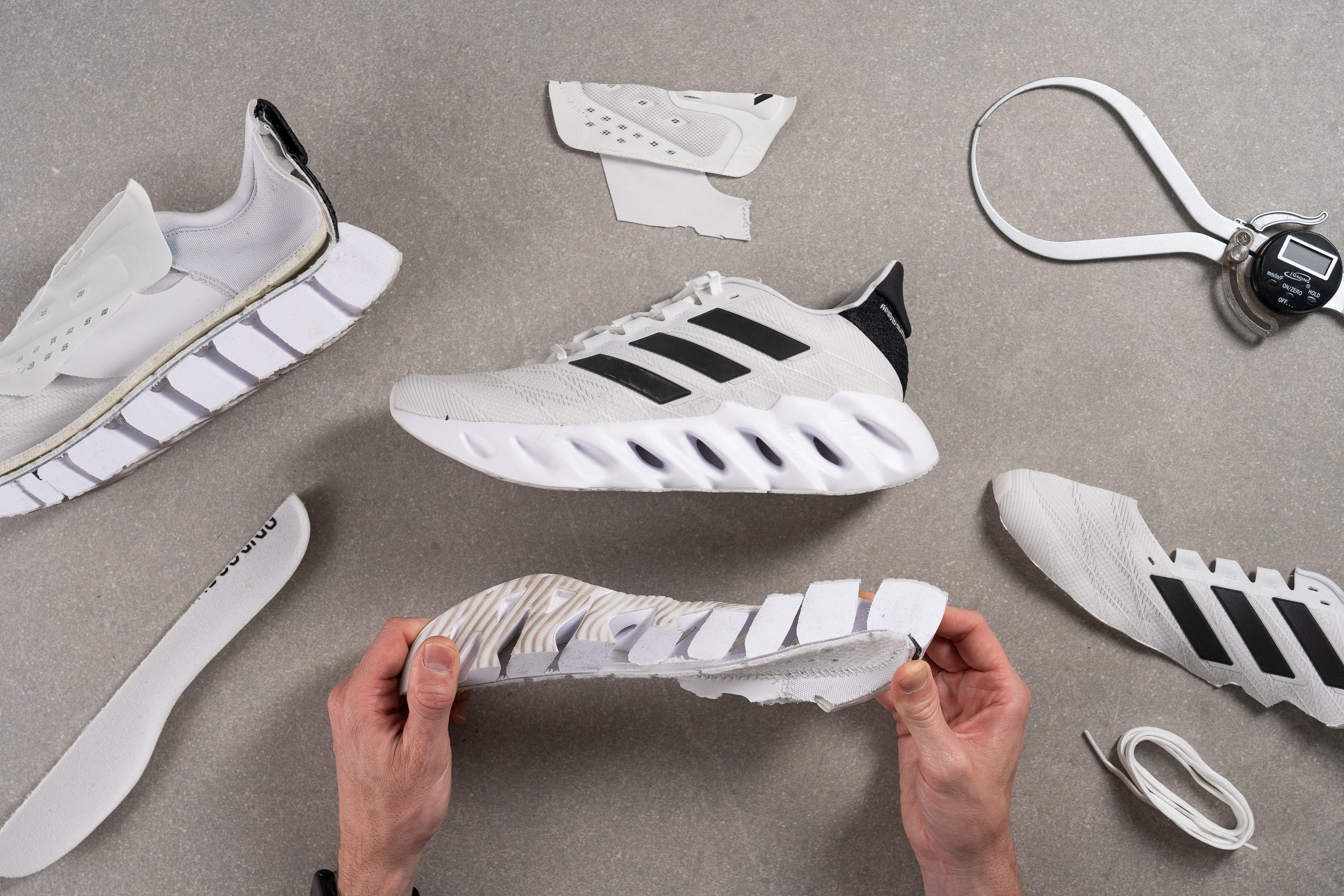
Amortiguación
Altura de la suela en la zona del talón
Una de las primeras cosas que vimos al analizar las Switch FWD originales fue que la altura de su suela en el talón era 5,2 mm más baja de la anunciada, pero esto también se ha corregido.
En la versión actualizada, la altura del talón es de 44,0 mm. Sí, sí, son un rascacielos hecho zapatillas. También comprobamos que la amortiguación es prácticamente infinita, lo que hace que sean un sueño para los talonadores que más pesan.
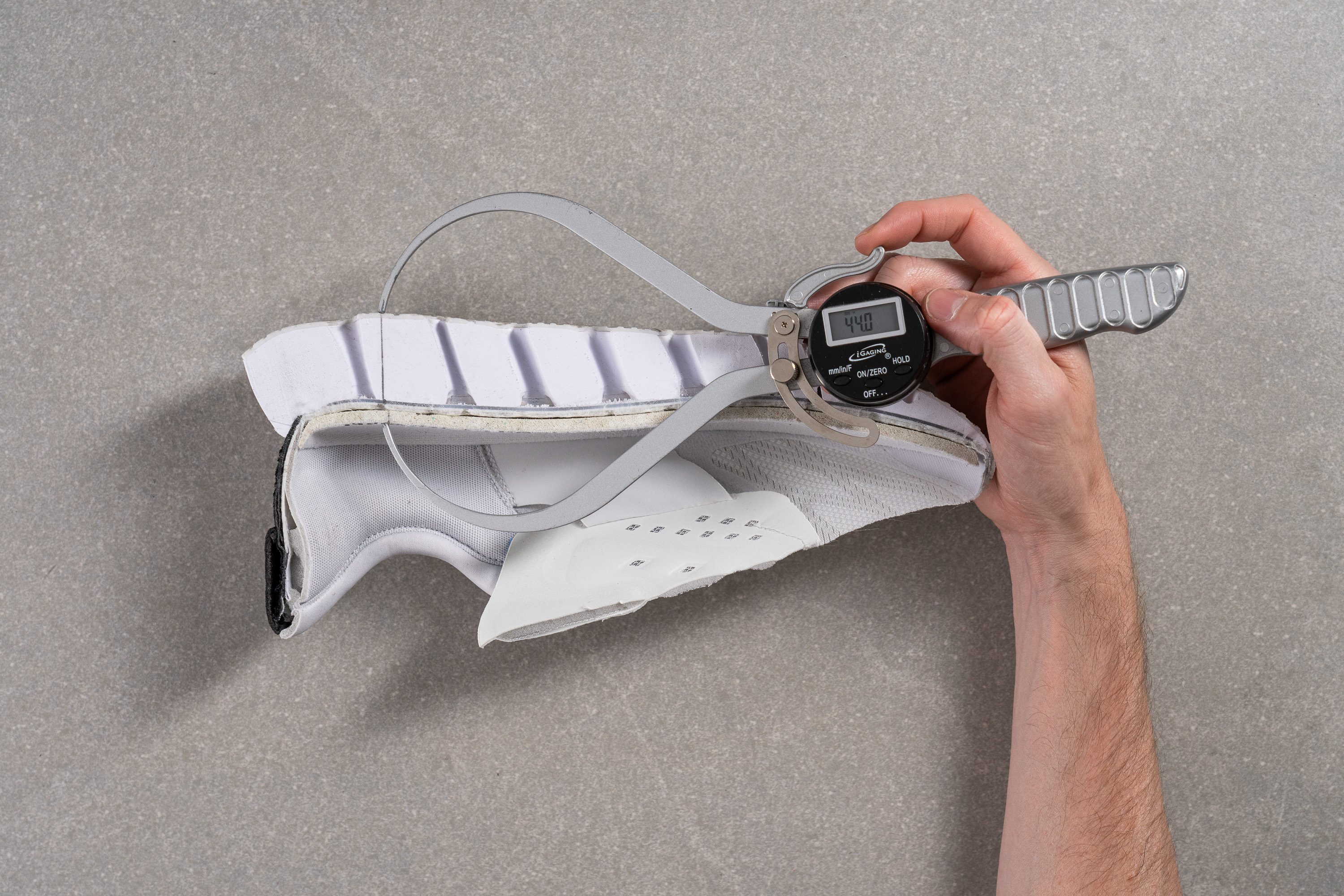
| Switch FWD 2 | 44.0 mm |
| Media | 34.8 mm |
Altura de la suela en el antepié
El antepié también es muy alto, ya que mide 32,3 mm. Aunque no llama tanto la atención como el talón, hace que estas zapatillas se ganen su puesto como modelo de entrenamiento diario maximalista.
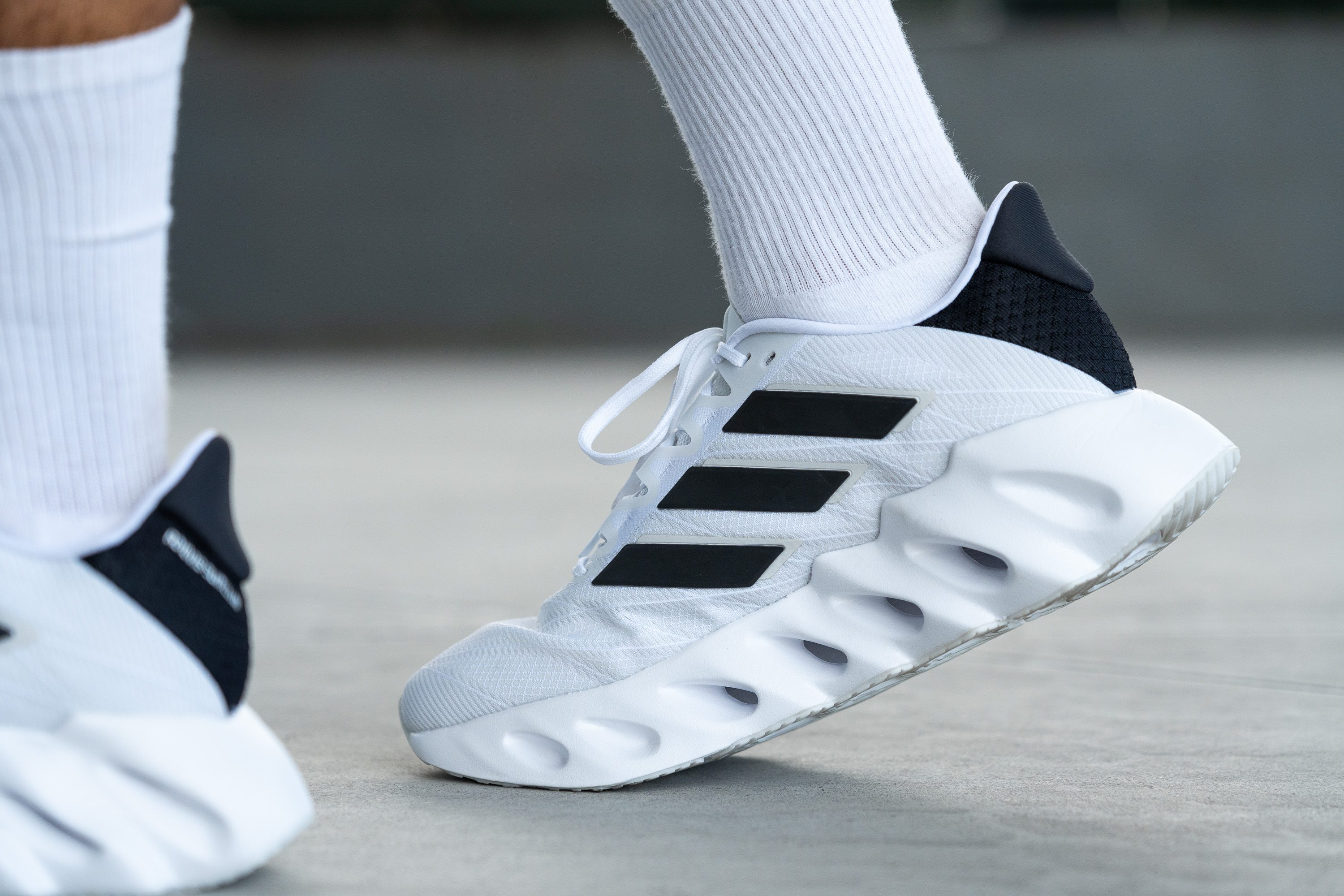
También es importante destacar que, aunque el antepié no es tan alto como el talón, tiene menos recortes en lamediasuela, lo que significa que la amortiguación ¡general en neto es parecida.

| Switch FWD 2 | 32.3 mm |
| Media | 26.2 mm |
Drop
Con solo echarles un ojo a las Switch FWD 2 después de cortarlas por la mitad, nos ha quedado claro que son unas zapatillas de running con un drop alto. Más concretamente, de 11,7 mm, y descubrimos que esto hace que las zapatillas sean mucho más adecuadas para los talonadores.
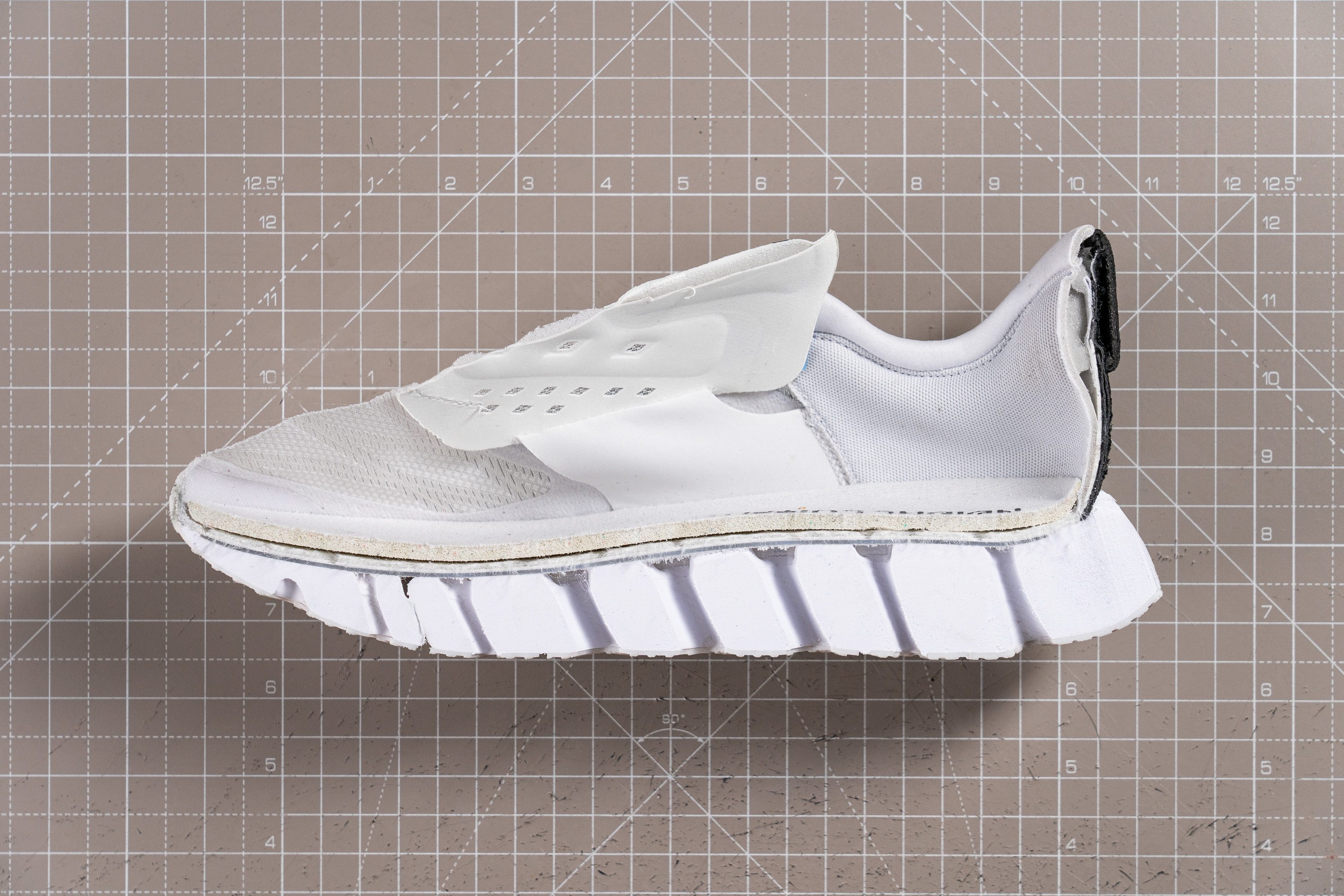
| Switch FWD 2 | 11.7 mm |
| Media | 8.6 mm |
Suavidad de la mediasuela
El aspecto más intrigante de las Switch FWD 2, al menos en la teoría, es el diseño de su mediasuela al estilo On, que rompe totalmente con lo que solemos ver tanto en nuestro laboratorio como por la calle. Promete algo diferente, pero..., ¿lo es?
A ver, la respuesta es un poco complicada. Visualmente, parece que la mediasuela va a tener mucho rebote y reactividad pero, en verad, se queda corta. La espuma EVA no tiene tanta energía como parece y, a pesar de su diseño, no ofrece tanto impulso hacia delante como cabría esperar.
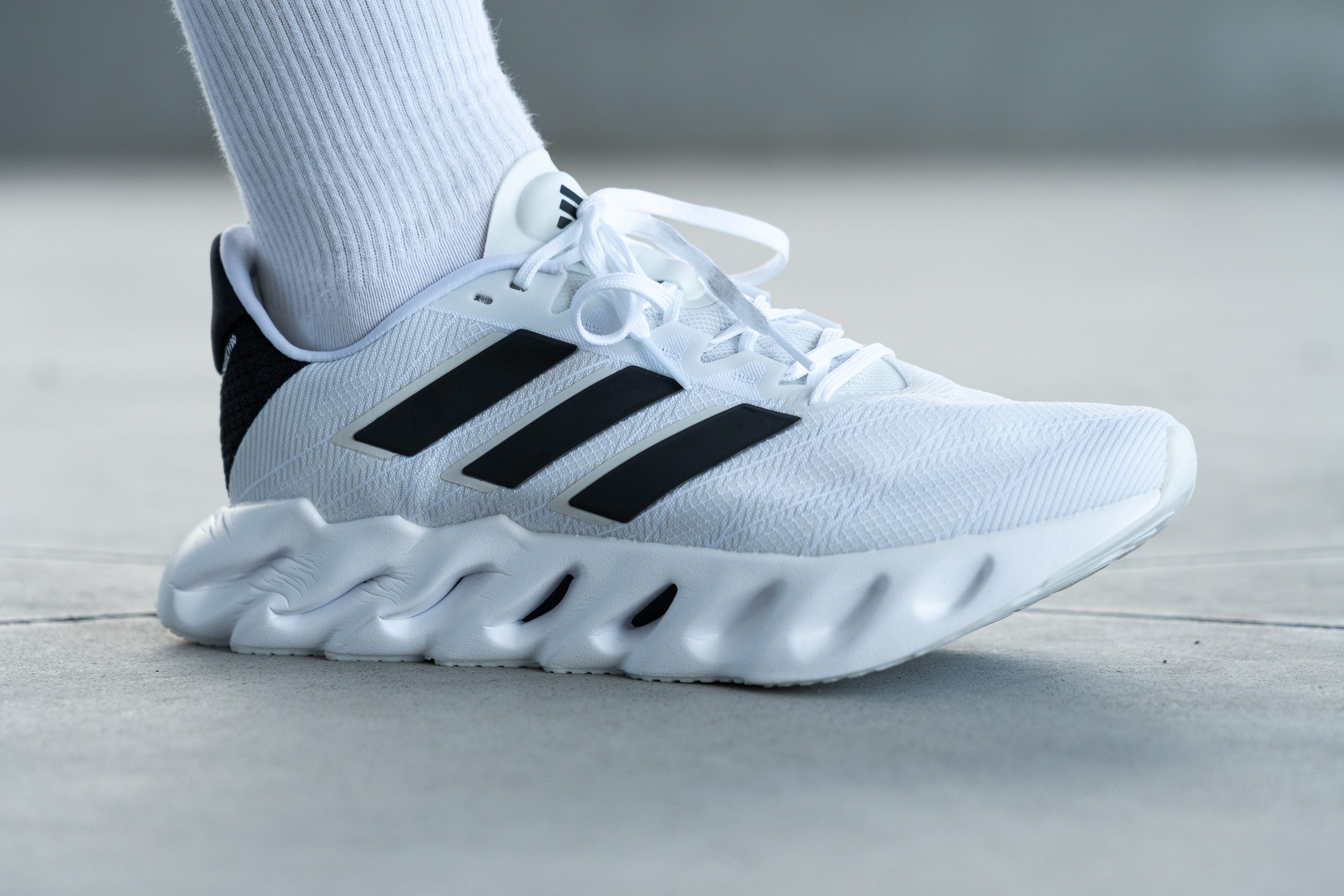
Adidas hizo que este modelo fuese más mullido que la versión 1, haciendo que su espuma fuese más blanda (pasando de 27,3 HA a 23,5 HA), pero esto no se traduce totalmente como una pisada notablemente más blanda. De hecho, diríamos que incluso es más bien firme, y samos que esto se debe a la placa de TPU que tienen, que está por encima de la mediasuela.

| Switch FWD 2 | 23.5 HA |
| Media | 20.4 HA |
Placa
Adidas decidió ponerles una placa rígida de TPU encima de la mediasuela a las Switch FWD 2, justo debajo de su plantilla. Este detalle proporciona una sensación más firme que la que ofrecería la espuma por sí sola.
Aunque la placa es esencial para la estabilidad (sobre todo con una plataforma así de alta y teniendo en cuenta el diseño de la mediasuela), creemos que si la plantilla fuese un poco más gruesa, las zapatillas serían bastante más cómodas: la pisada sería más mullida pero no sacrificaría la sujeción, que es muy necesaria.

Tallaje y ajuste
Talla
Las Adidas Switch FWD 2 tallan bien (33 votos).
Anchura / Ajuste
Con ese diseño tan poco convencional, el ajuste de estas zapatillas podría haber sido de cualquier tipo. Sin embargo, cuando medimos su anchura en el laboratorio, nos dio 99,2 mm, una cifra coherente con la de muchas zapatillas de running.
Pero es muy importante tener en cuenta que el upper de este modelo no se adapta bien a las personas con pies grandes, ya que su volumen vertical está bastante limitado. ¿Lo peor de todo? Pues que cogerse estas zapatillas en una talla más no soluciona el problema.

En esta prueba se utiliza una metodología antigua, así que no verás las zapatillas que hemos analizado últimamente en la tabla. Los resultados obtenidos con metodologías distintas no se pueden comparar.
| Switch FWD 2 | 99.2 mm |
| Media | 98.5 mm |
Anchura de la parte delantera
Lo bueno es que la zona de los dedos de este modelo no se estrecha tanto como la de otras zapatillas de Adidas, que suelen terminar más en punta.
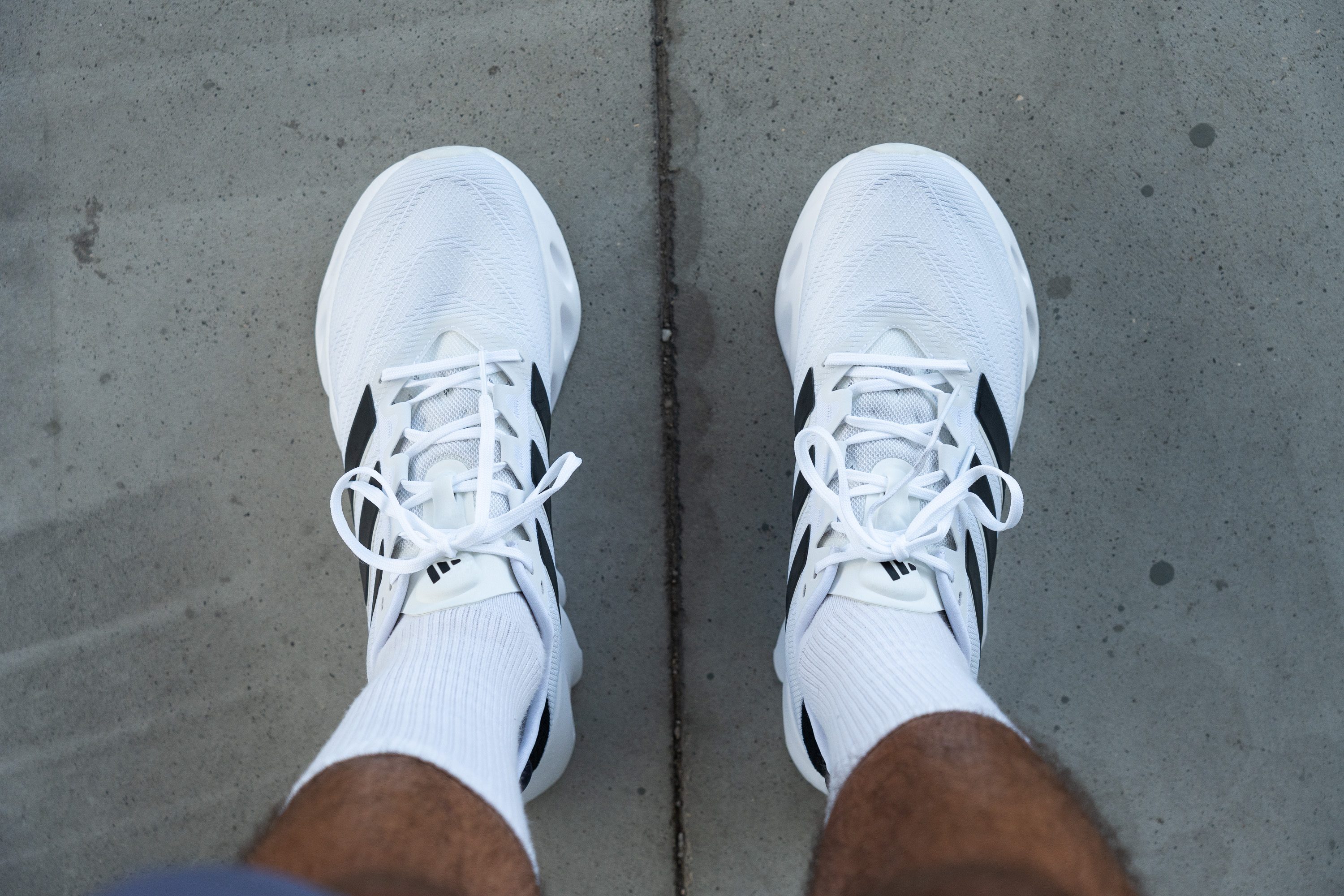
De hecho, con una anchura de 78,9 mm, tienen más espacio en esta zona que muchos modelos de la competencia.
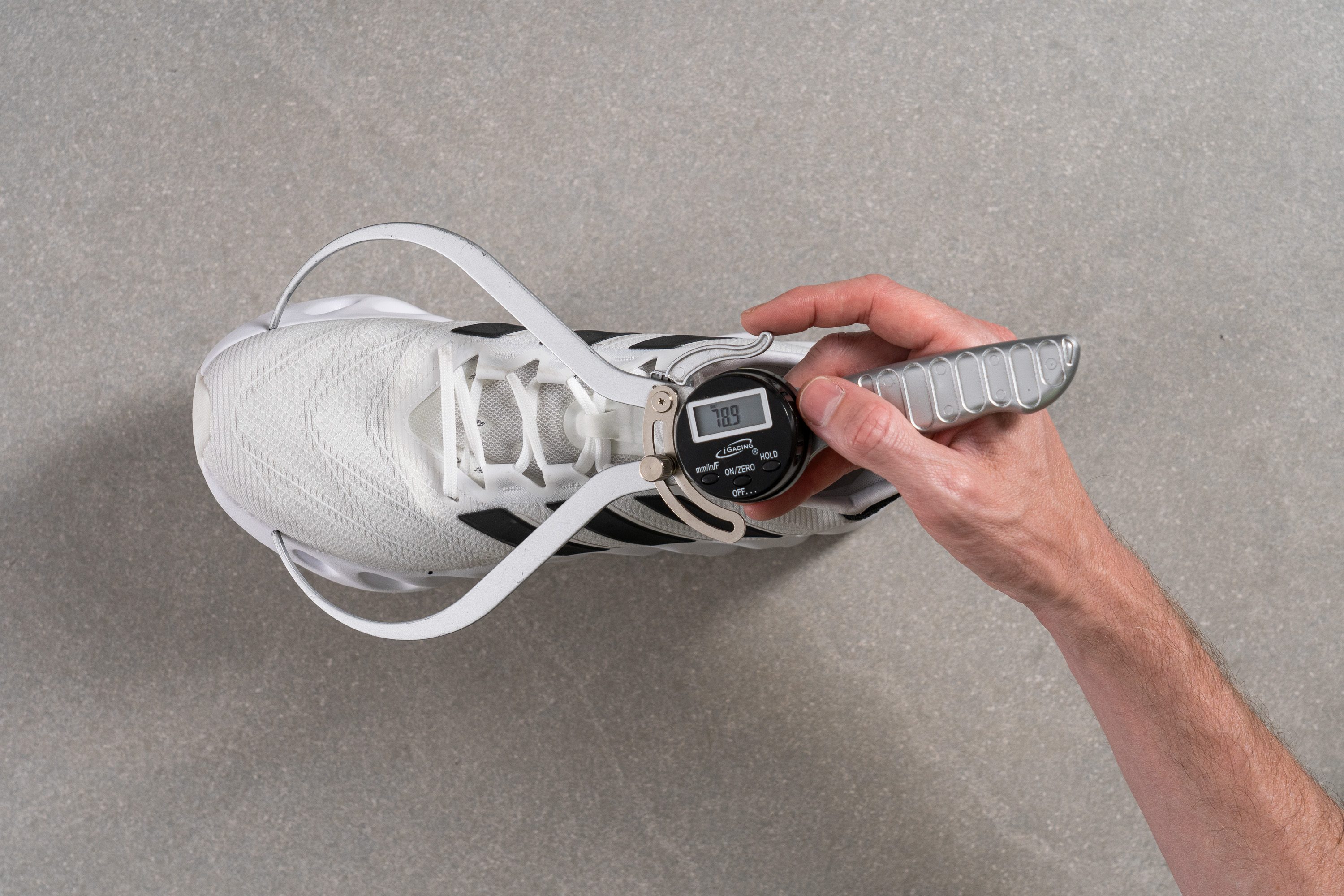
En esta prueba se utiliza una metodología antigua, así que no verás las zapatillas que hemos analizado últimamente en la tabla. Los resultados obtenidos con metodologías distintas no se pueden comparar.
| Switch FWD 2 | 78.9 mm |
| Media | 78.4 mm |
Flexibilidad / Rigidez
Las Switch FWD 2 confirman, una vez más, algo que vemos en nuestro laboratorio con mucha frecuencia, y es que, contrario a lo que se puede pensar, ni las placas de TPU ni las de nylon aumentan demasiado la rigidez longitudinal de las zapatillas. Este modelo solo necesitó 18,9 N para doblarse 90 grados en nuestra prueba de flexión, así que nos parece muy adecuado para un uso casual. Siempre y cuando su estilo no te asuste, claro.
Su flexibilidad viene, en gran medida, de todos los cortes que tienen en la mediasuela y en la suela exterior. Estos detalles tienen varios propósitos, como por ejemplo la reducción de la rigidez.
En esta prueba se utiliza una metodología antigua, así que no verás las zapatillas que hemos analizado últimamente en la tabla. Los resultados obtenidos con metodologías distintas no se pueden comparar.
| Switch FWD 2 | 18.9N |
| Media | 28.1N |
Rigidez en frío (%)
La rigidez de las FWD aumentó un 38,5 % después de que se pasasen 20 minutos en nuestro congelador. Pero es una reacción típica de unas zapatillas con una mediasuela de EVA, ya que este material se endurece a bajas temperaturas.
| Switch FWD 2 | 39% |
| Media | 33% |
Peso
Una de las principales desventajas de las Switch FWD originales es lo pesadas que son, ya que sus 323 g nos parecen demasiado, sobre todo para un modelo con tantos recortes en la mediasuela. Por suerte, Adidas lo ha solucionado.
Este modelo pesa ahora 288 g, así que estamos mucho más contentos. Eso sí, esta mejora se produce a costa de la durabilidad de la suela exterior. Pero si la primera versión te parecía tosca y priorizas la ligereza, probablemente te guste esta actualización.

| Switch FWD 2 | 10.2 oz (288g) |
| Media | 9.3 oz (264g) |
Transpirabilidad
Después de echarles un ojo al sacarlas de la caja, las Switch FWD 2 nos hicieron pensar que no iban a ser las mejores en cuanto a transpirabilidad. A su parte superior, que está fabricada con una malla de ingeniería más gruesa, no le vimos agujeritos para que el aire entrase y saliese, así que nos las llevamos a nuestro laboratorio para ver si esto es cierto.
Nuestra máquina de humo nos lo dejó claro: las Switch FWD 2 se quedan cortas en transpirabilidad. El 3/5 que se llevaron en esta prueba está por debajo de la media de las zapatillas para correr por asfalto, lo que indica que este modelo rinde mejor cuando hace fresquito, y peor cuando hace calor.
Cuando cogimos un cacho de su upper y lo pusimos frente a nuestra luz LED, vimos que brillaba un poquito por la zona de los dedos, pero la mayor parte de este modelo tiene un material muy denso y estructurado que retiene eficazmente el calor, lo que no es ideal para cuando suben las temperaturas.
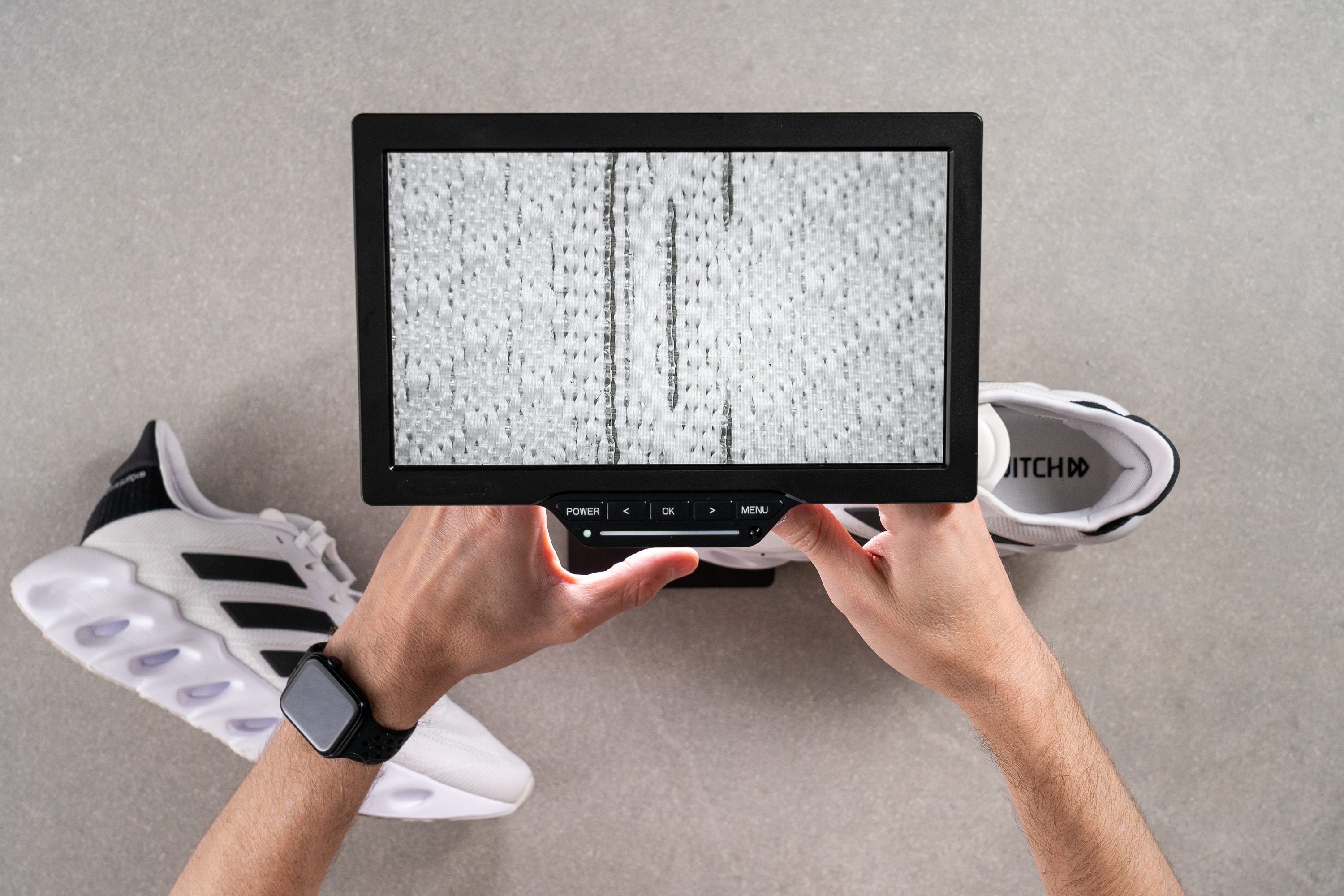
Gracias a nuestro microscopio, descubrimos que hay agujeritos verticales muy pequeños colocados estratégicamente por la marca con el objetivo de intentar mejorar la transpirabilidad. Aunque sí que ayudan, no creemos que sea suficiente; pero bueno, sin ellos, la puntuación en transpirabilidad de este modelo habría sido, muy probablemente, un desastre total.
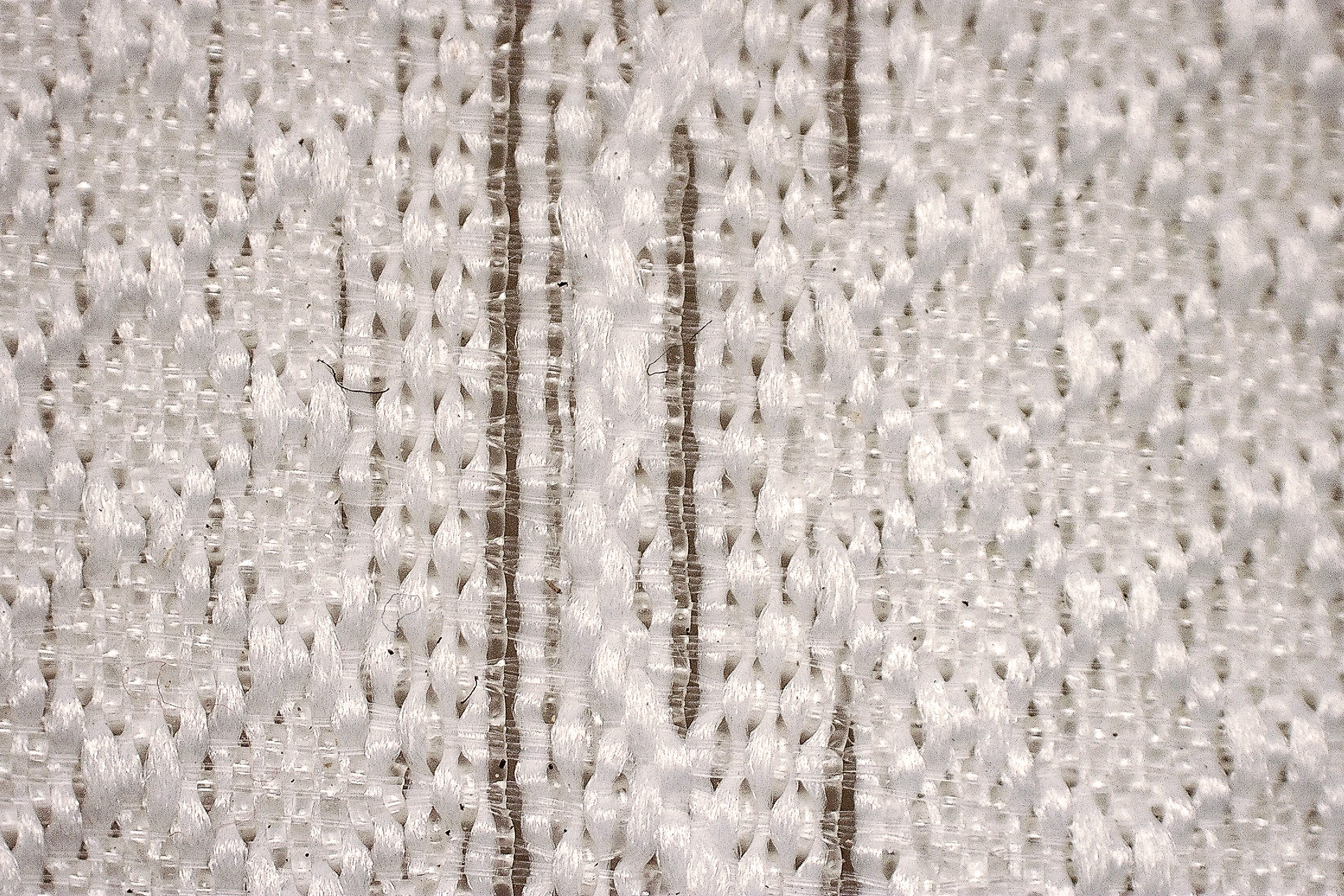
La transpirabilidad general y la estructura de la parte superior también revelaron que estas zapatillas no están diseñadas para correr sin calcetines. Ni dan de sí lo suficiente ni cuentan con el acolchado necesario, además de que tienen costuras expuestas que podrían causar molestias, confirmando así nuestro análisis.
| Switch FWD 2 | 3 |
| Media | 3.7 |
Estabilidad
Prueba de estabilidad lateral
Aunque las Switch FWD 2 son altísimas y parecen estrechas (sobre todo si las miras desde atrás), su maravillosa estabilidad consiguió dejarnos boquiabiertos. Nos pareció una de sus características más destacadas e inesperadas.
Rigidez torsional
Las Switch FWD 2 tienen varias características que se centran en mejorar su estabilidad, como su firme espuma EVA o su alta rigidez torsional. Cuando comprobamos esta última con las manos, nos costó tanto retorcer este par que decidimos darle un 4/5, y se lo debe a la placa de TPU de longitud completa que Adidas le puso.
| Switch FWD 2 | 4 |
| Media | 3.5 |
Rigidez del contrafuerte del talón
Descubrimos que el contrafuerte del talón de las FWD 2 consigue ofrecer un buen equilibrio en términos de rigidez. Diríamos que su firmeza es moderada, así que le hemos dado un 3/5 en esta prueba. Vamos, que proporciona sujeción suficiente pero sin pasarse de rígido. Esto hace que sea adecuado para una gran variedad de corredores, garantizando tanto estabilidad como comodidad.
| Switch FWD 2 | 3 |
| Media | 2.9 |
Anchura de la mediasuela - antepié
Lo que realmente nos llamó la atención después de analizar la mediasuela fue lo ancha que es en el antepié. Cuando la medimos, nos dio 122,4 mm, así que la plataforma de aterrizaje es muy amplia.
La mayoría de los corredores se beneficiarán de su estabilidad y amortiguación pero, como dijimos antes, estas zapatillas nos parecen más adecuadas para los talonadores o los corredores de mediopié/metatarsos que necesiten un drop más alto.
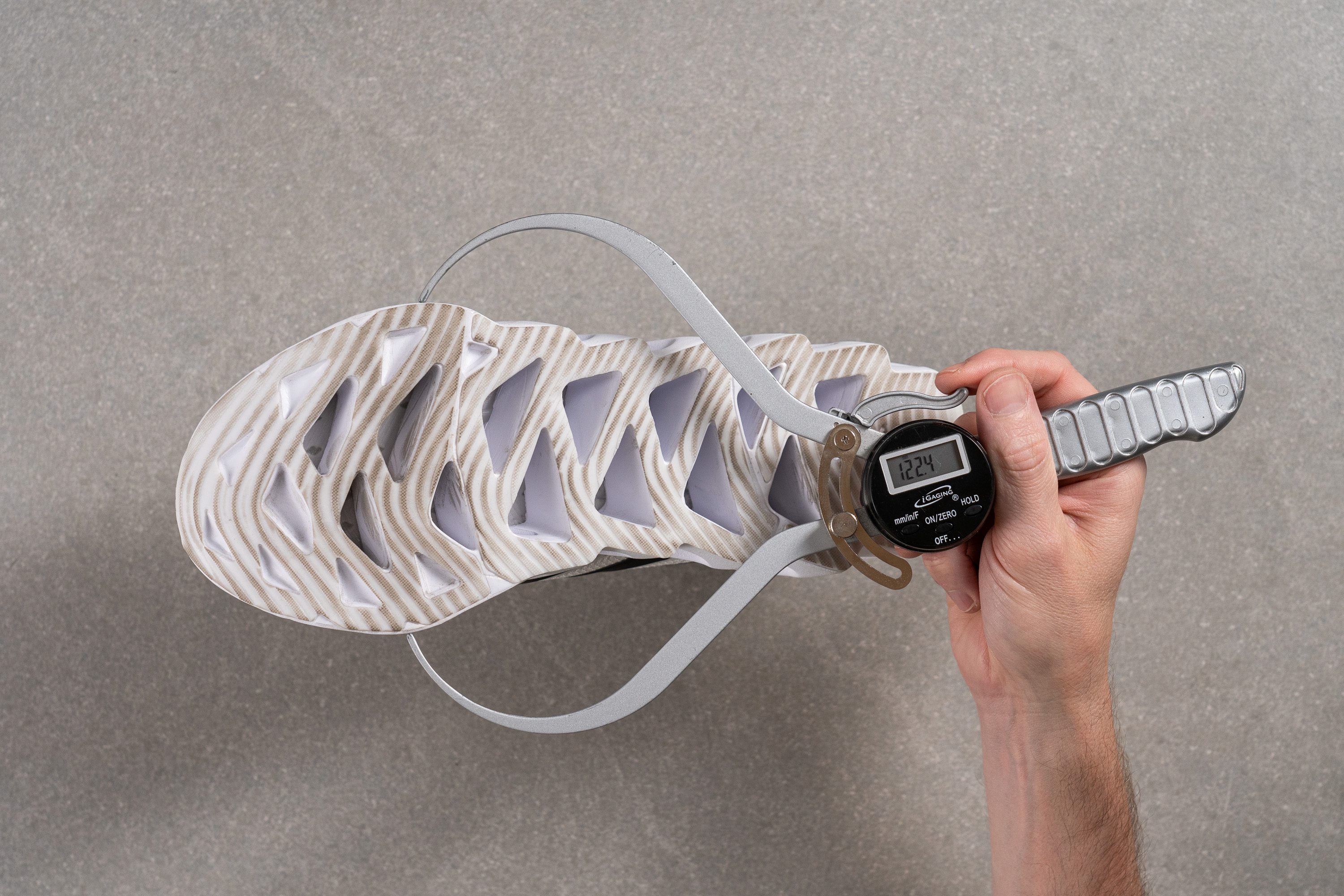
| Switch FWD 2 | 122.4 mm |
| Media | 114.4 mm |
Anchura de la mediasuela - talón
Nos sorprendió comprobar que, aunque estas zapatillas tienen un antepié de una anchura de 122,4 mm, el talón solo llega a los 89,4 mm, una medida bastante estándar en comparación. Esta elección de diseño por parte de Adidas nos ha dejado un poco confundidos, ya que este modelo se dirige, principalmente, a los talonadores, y al final no es muy común ver tal discrepancia entre la anchura del antepié y la del talón.
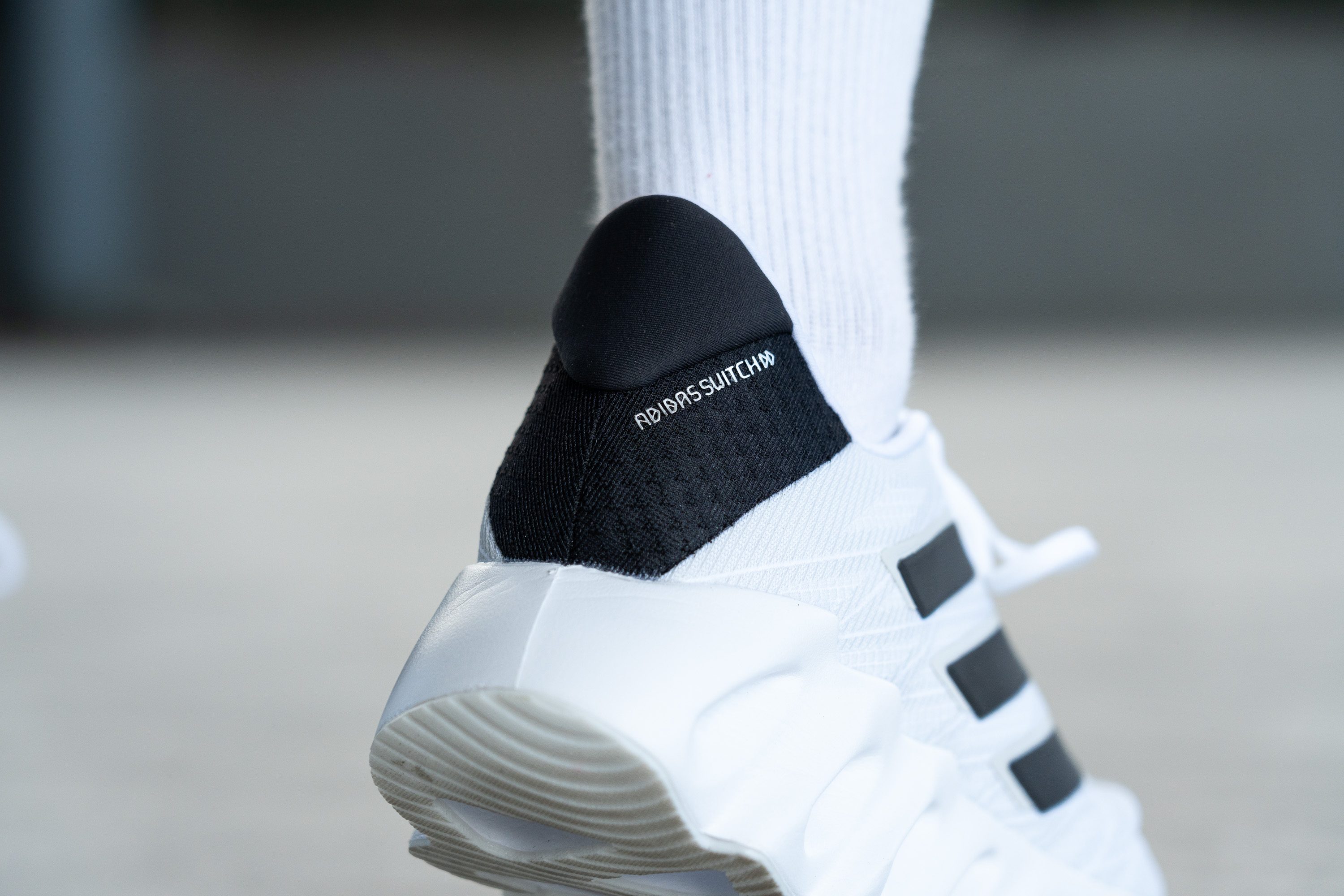
Pero estas zapatillas son más estables de lo que parece, lo que puede deberse a su peso. Al final conseguir equilibrar una estructura más amplia sin aumentar el peso parece haber sido complicado para Adidas.
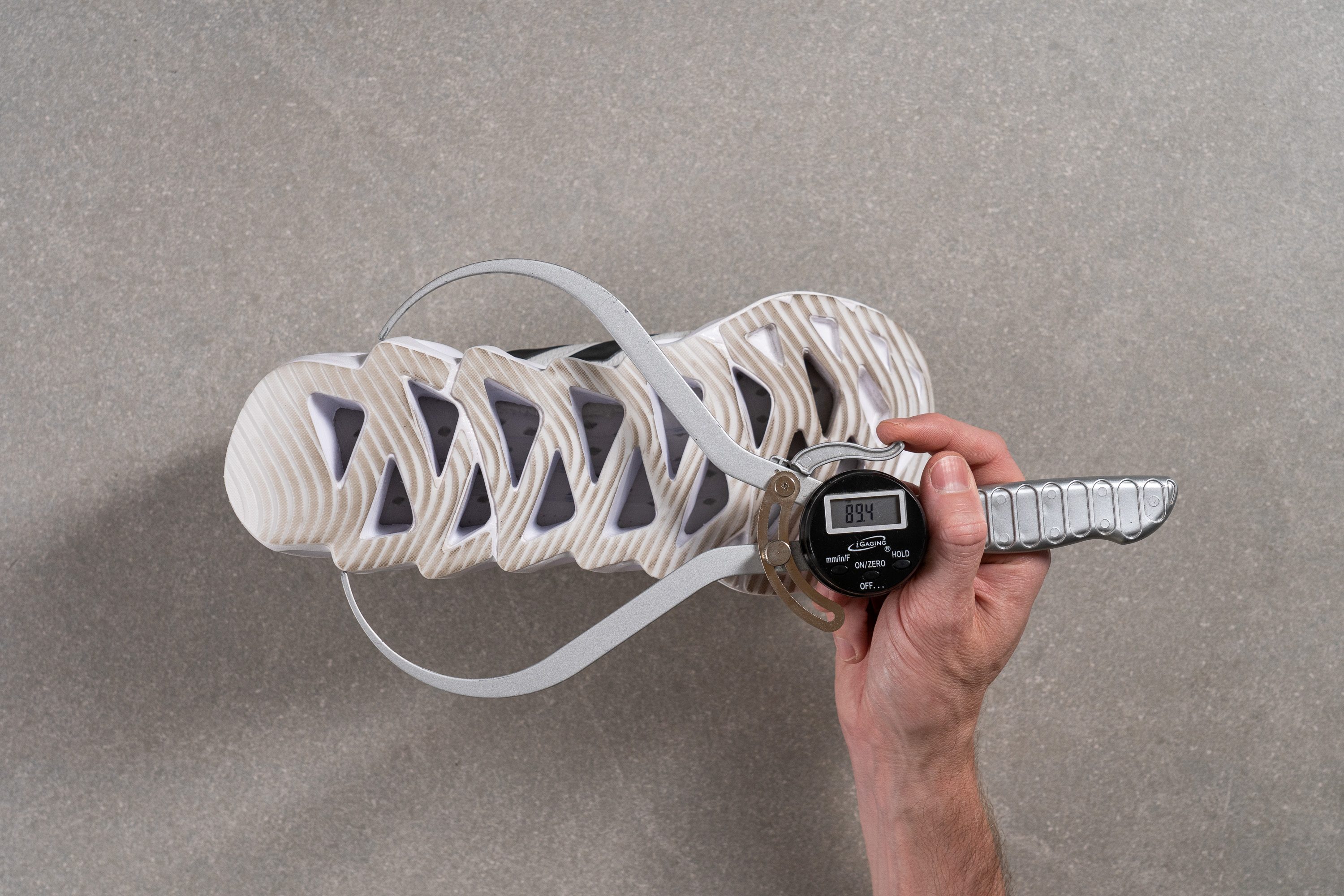
| Switch FWD 2 | 89.4 mm |
| Media | 90.7 mm |
Durabilidad
Durabilidad de la parte delantera
Una vez aceptada la falta de transpirabilidad de esta parte superior, nos centramos en la durabilidad, que suele ser el punto fuerte de los materiales más densos. Esta vez nos esperábamos un resultado mejor, ya que la primera generación de las Switch FWD obtuvo malos resultados en esta prueba.
Las pusimos a prueba con nuestro Dremel con 3,2 N de fuerza y a 5.000 RPM. La verdad es que aguantaron bastante bien, llevándose un respetable 3/5 en durabilidad, lo que hace que estén en el medio de la tabla. Aunque su rendimiento no nos dejó impresionados, consiguieron superar este reto.
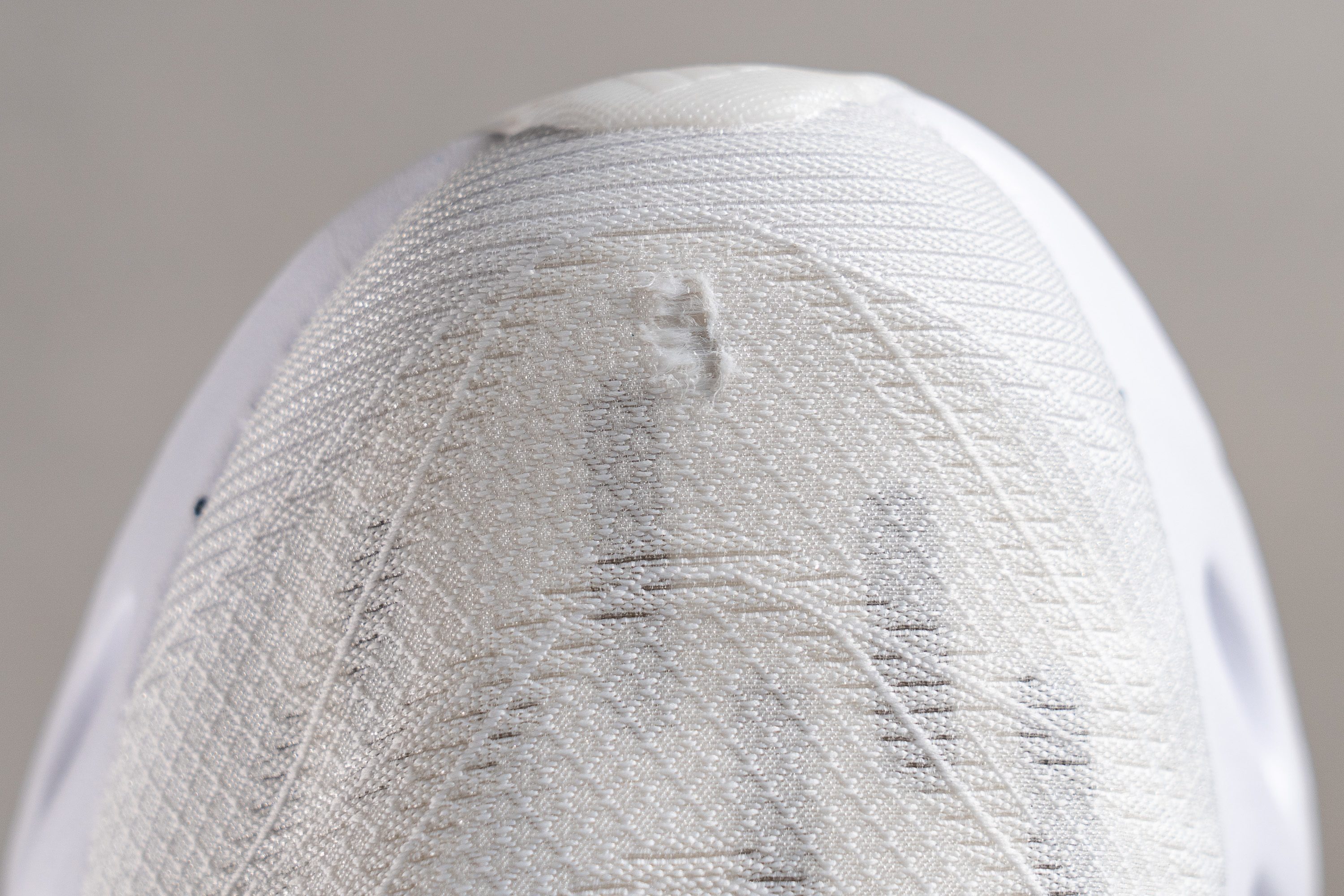
| Switch FWD 2 | 3 |
| Media | 2.6 |
Durabilidad del acolchado del talón
El cuello del talón de las Switch FWD 2 tiene un diseño único, ya que tiene un extra de acolchado en el talón que sujeta el tendón de Aquiles, evitando el deslizamiento del talón, además de que su estructura es más alta.
Eso sí, superó a la zona de los dedos en cuanto a durabilidad, llevándose un sólido 4/5 en nuestras pruebas. Creemos que este diseño ofrece tanto comodidad como durabilidad.
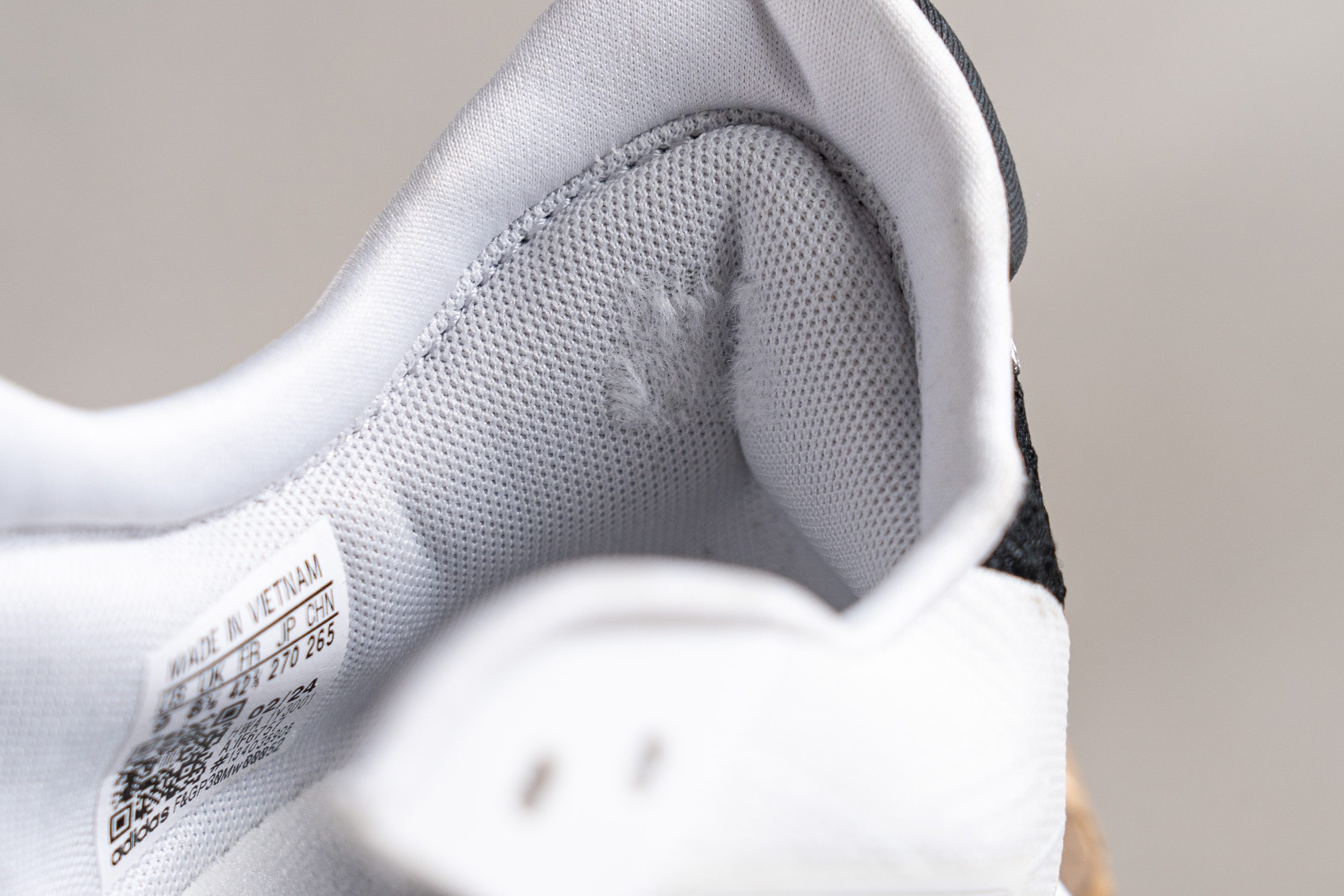
| Switch FWD 2 | 4 |
| Media | 3.4 |
Dureza de la suela
La suela exterior sí que ha cambiado bastante con respecto a la generación anterior, aunque no todo haya sido para mejor. En cuanto a diseño, sigue siendo una coleccionista de piedras, ya que tiene unos agujeros grandes cuya profundidad llega hasta la plantilla.
Sin embargo, cuando se trata de agarre, destaca mucho gracias al famoso caucho Continental.
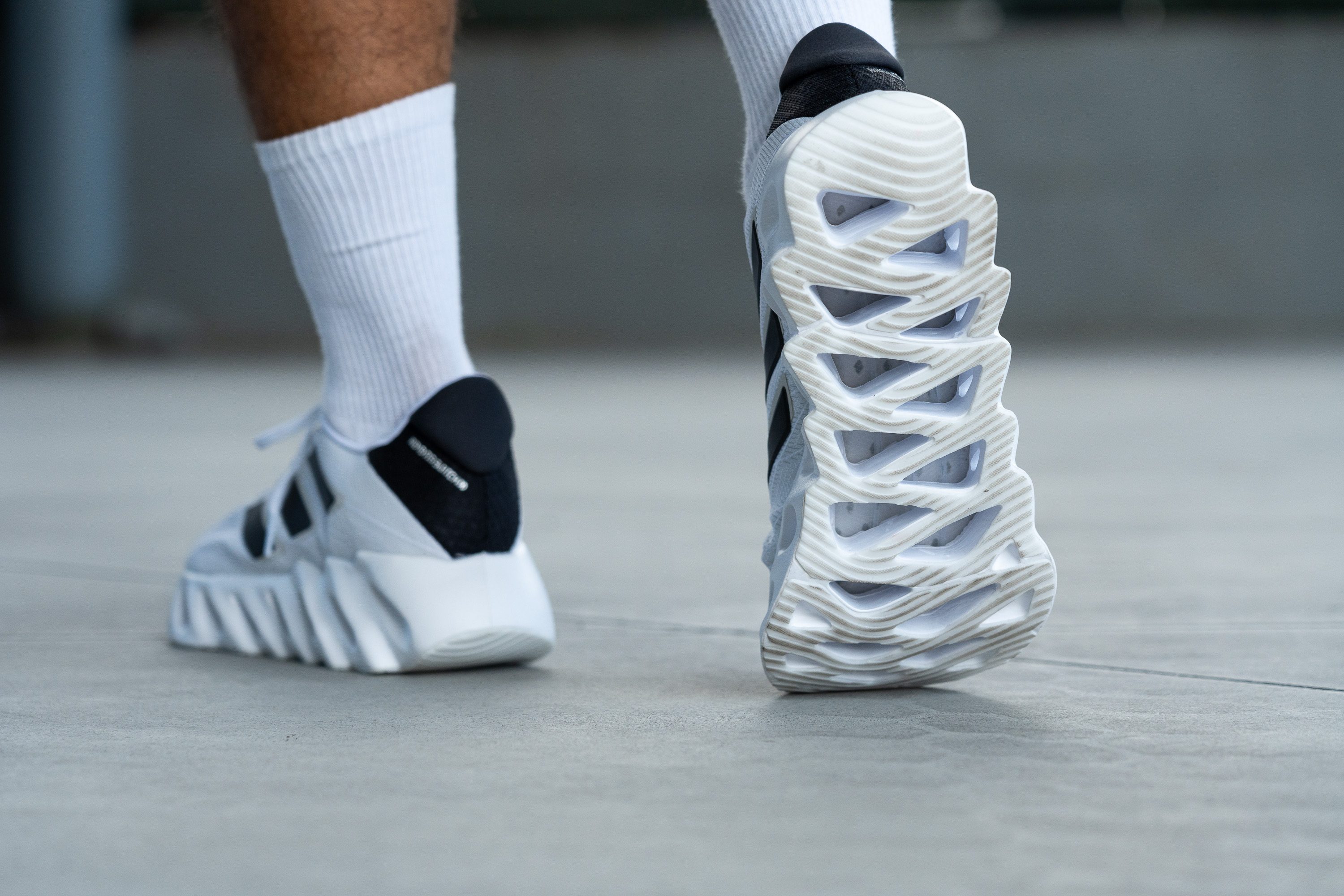
Curiosamente, Adidas no les puso el logotipo de Continental en la suela exterior como en la primera versión. Cuando analizamos el caucho, nos dimos cuenta de que era más blando de lo esperado, ya que nuestro durómetro marcó 72,6 HC, lo que podría afectar negativamente a la durabilidad a largo plazo.

| Switch FWD 2 | 72.6 HC |
| Media | 79.2 HC |
Durabilidad de la suela
Nuestros peores temores se confirmaron cuando cogimos el Dremel por tercera y última vez.
Al medir los daños, vimos que tenían una profundidad de 1,6 mm. Sí, es un resultado muy malo, además de una clara caída en picado en durabilidad con respecto a la primera generación.
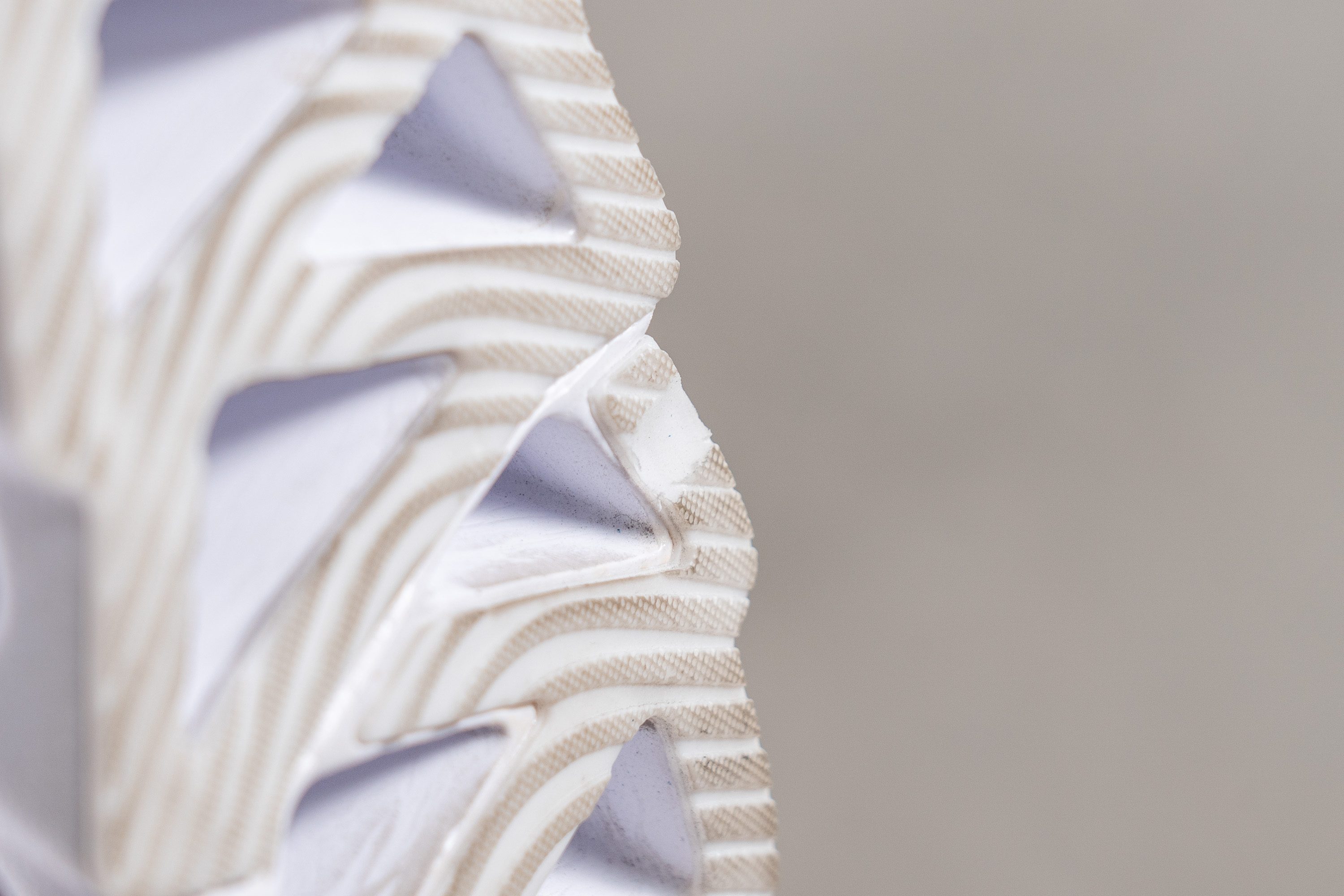
| Switch FWD 2 | 1.6 mm |
| Media | 1.1 mm |
Grosor de la suela
Cuando medimos el caucho, vimos que solo tiene 2,3 mm de grosor, así que es 1,0 mm más finito que el de la v1. Por lo tanto, no podemos recomendarles estas zapatillas a los corredores que desgastan rápido la suela exterior.
También hemos visto que tienen menos superficies de contacto con el suelo en comparación con las de otras zapatillas, así que el desgaste se producirá más rápido que en la mayoría de los modelos de entrenamiento diario. Esto podría ser un problema para las personas que están buscando un modelo duradero.
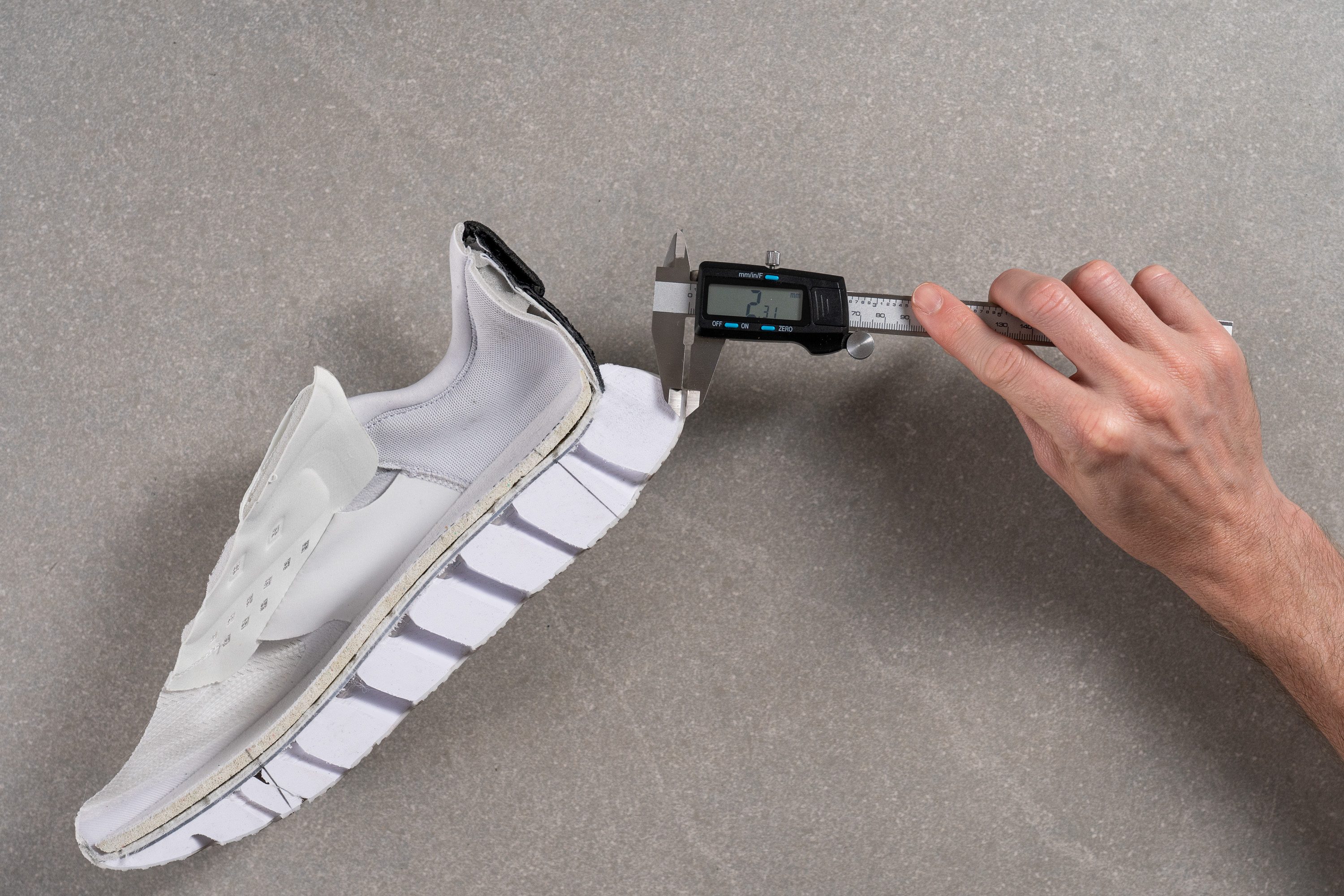
| Switch FWD 2 | 2.3 mm |
| Media | 3.2 mm |
Varios
Grosor de la plantilla
La plantilla está hecha de espuma EVA reciclada, y es uno de los pocos elementos de estas zapatillas que parece bastante estándar. Tiene un diseño sencillo y sin florituras de 4,8 mm de grosor.
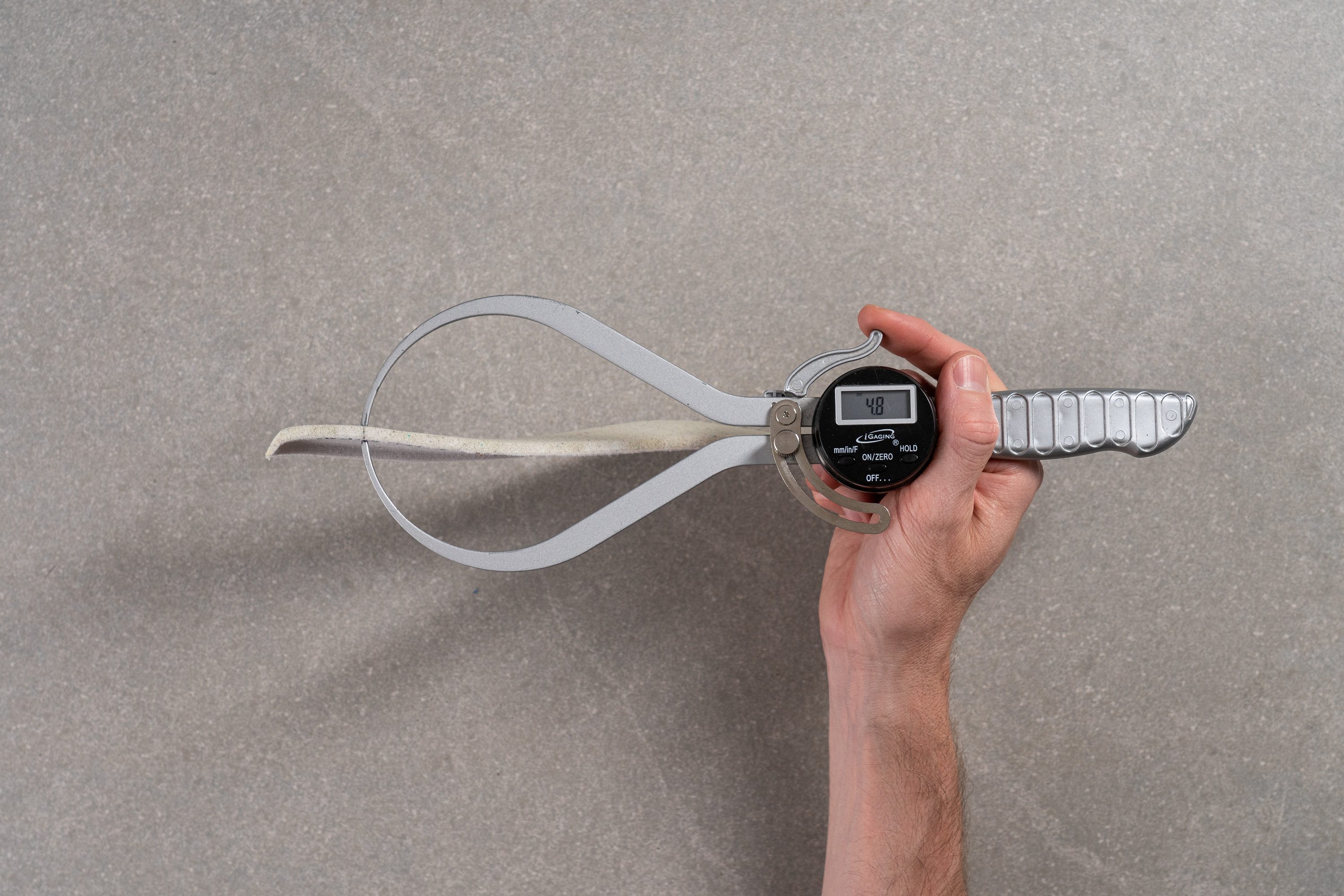
| Switch FWD 2 | 4.8 mm |
| Media | 4.5 mm |
Plantilla extraíble
No hemos tenido problemas para cambiar la plantilla de las FWD 2, y como la que traen de serie es bastante básica, tampoco perdimos nada al hacerlo.

| Switch FWD 2 | Sí |
Rigidez de la mediasuela en frío (%)
Metimos las FWD 2 en nuestro congelador durante 20 minutos para comprobar su rendimiento cuando bajan las temperaturas. La espuma se volvió un 27,1 % menos blanda, lo que consideramos un cambio típico para la espuma EVA.
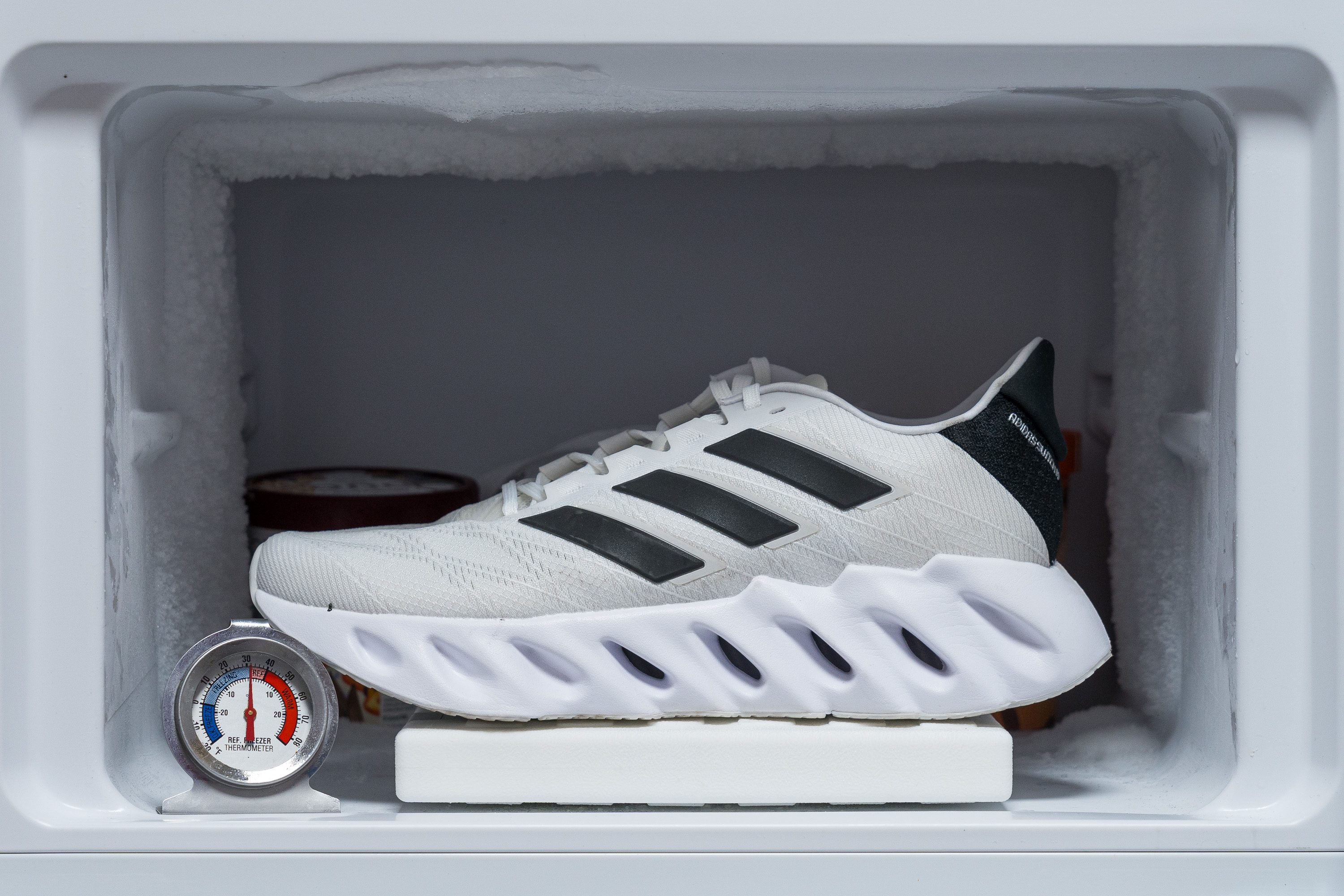
| Switch FWD 2 | 27% |
| Media | 24% |
Elementos reflectantes
Pocas zapatillas de entrenamiento diario tienen detalles reflectantes, pero las Switch FWD 2 rompen esa norma: las grandes rayas del logo de Adidas no solo llaman la atención, sino que también reflejan la luz, aumentando la seguridad cuando sales a correr.
| Switch FWD 2 | Sí |
Acolchado de la lengüeta
La lengüeta de las Switch FWD originales era uno de sus puntos más fuertes gracias a su comodidad y a su diseño aerodinámico, y nos alegró descubrir que la segunda generación mantiene el mismo acolchado de 5,0 mm.
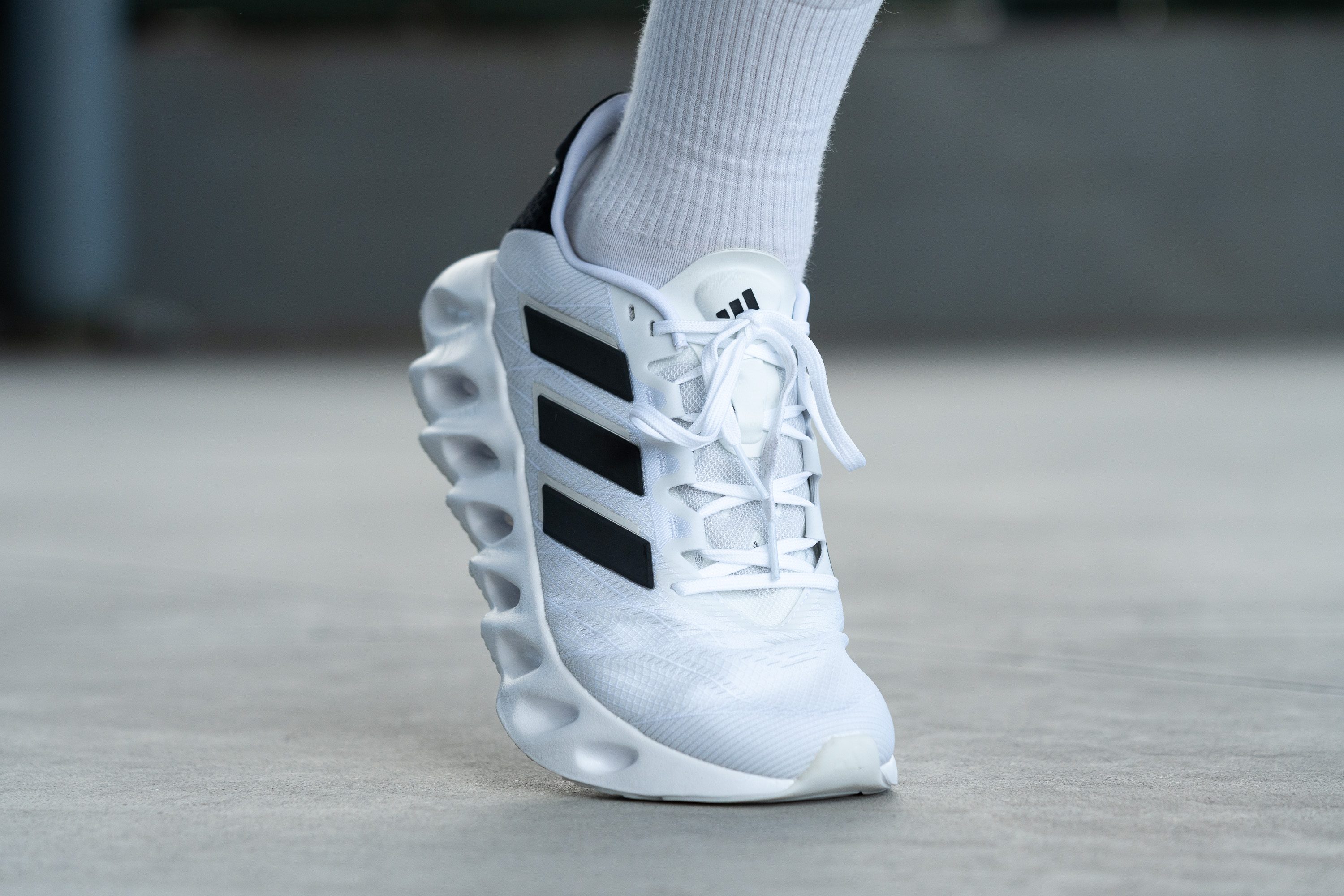
Según nuestra experiencia, es el diseño ideal para el uso diario, ya que equilibra a la perfección ligereza y comodidad. Aunque el sistema de cordones híbrido no es el mejor que hemos visto en nuestro laboratorio, ya que tiene lacitos en vez de perforaciones, sigue siendo eficaz.
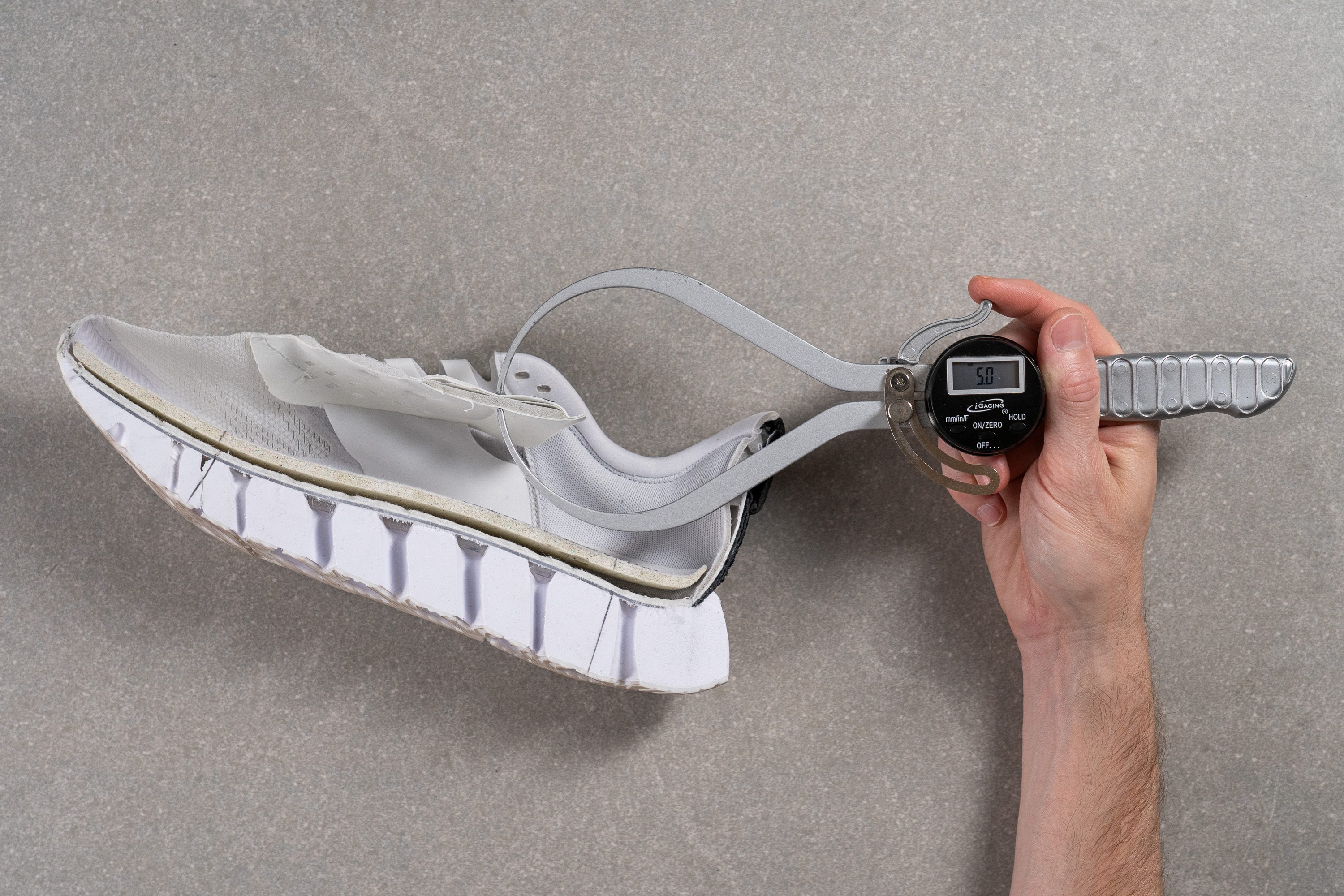
| Switch FWD 2 | 5.0 mm |
| Media | 5.8 mm |
Lengüeta: tipo de refuerzo
No es habitual que unas zapatillas con este precio tengan una lengüeta que está fija a ambos lados, pero las Switch FWD 2 sí, ¡y qué alegría nos llevamos!

| Switch FWD 2 | Ambos lados (semi) |
Precio
Aunque estas zapatillas tienen un diseño único, su precio es bastante estándar, ya que iguala el coste medio de otros modelos de running de su clase. Estamos encantados de que no sean más caras que su versión anterior, ¡que es algo poco frecuente en el mercado actual!
| Switch FWD 2 | $140 |
Tirador del talón
Aunque el talón de las Switch FWD 2 está muy bien amortiguado, echamos de menos un tirador, y es que es un detalle muy práctico que vemos en la línea Adidas Adizero para hacer que calzarse sea más fácil.

| Switch FWD 2 | Ninguno |

